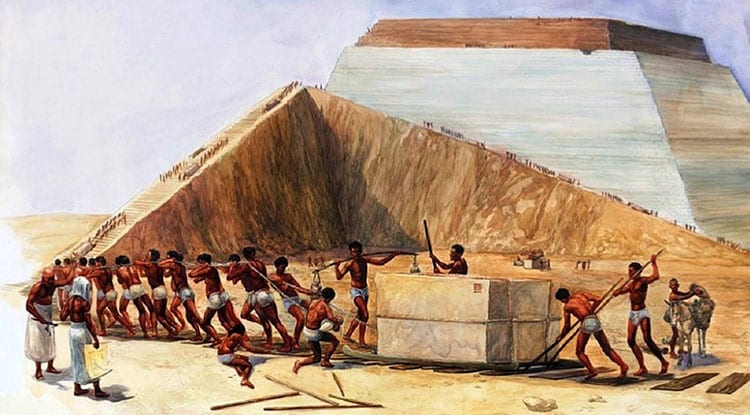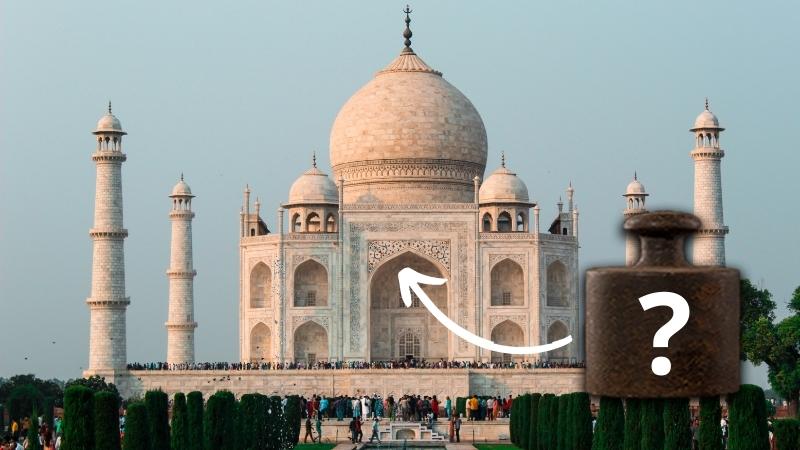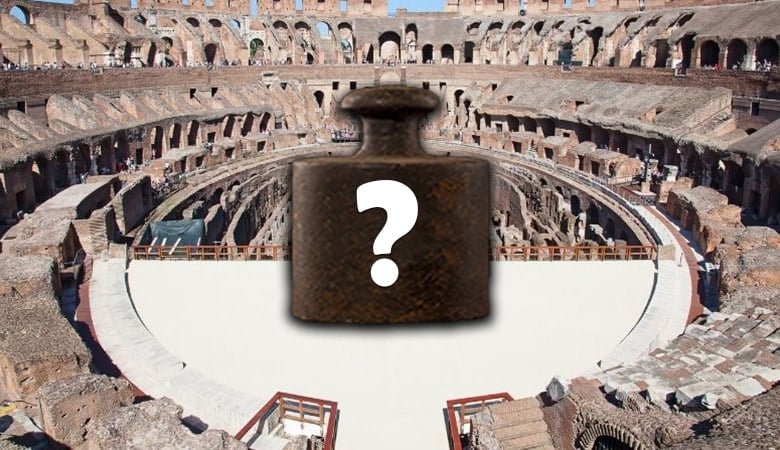How much does the Pyramid of Giza weigh? The Pyramid of Giza weigh about 5.75 million tons. This weight is made up of about 2.3 million blocks of stone that weighs about 2267.96 kg (about 2.3 metric tons) each.
One of the longest-standing mysteries that have amazed many people around the world is the Great Pyramid of Giza. Scientists, together with Egyptians, have for long been trying to unveil the mysteries surrounding this pyramid. Below are some of the things you should know about the Pyramid of Giza.
Are you impressed or scared about how heavy the pyramids are? Read on to learn more about this remaining member of the Seven Wonders of the World.
What makes up the weight of the Pyramid of Giza?
The Pyramid of Giza features three chambers i.e. queen, king, and the unfinished chamber. It is made up of blocks. There are about 2.3 million blocks in total. It is the tallest structure ever made by man (without machines) in about 3800 years. It has a height of 756 feet. To determine the weight of the pyramid, we consider the weight of each single building block used. Each of the estimated 2.3 million blocks of stone weighs about 2267.96 Kg (about 2.3 tons) each
The Great Pyramid of Giza is located at the border of Cairo in Egypt. It is believed that the pyramid was built over a time period of between 10-60 years by Pharaoh Khufu at around 2550 B.C. together with his successors including Khafre and Menkaure. It is also believed to be the oldest structure among the Seven Wonders of the Ancient World.
The pyramid has been considered the center of a tourist attraction with several researchers and archeologists visiting the area. The reason why Egyptians created the pyramid was to serve as a tomb to be used for their kings.
The Great Pyramid was built during the fourth dynasty of Pharaoh Khufu who ruled from 2589 B.C to 66 B.C. According to various sources, about 100,000 Hebrew slave laborers were used to build the pyramid. According to Herodotus, a Greek historian, it took them about 20 years to erect the structure.
Haman or Hemiunu is the person believed to be the architect of the Great Pyramid. He was referred to as Master of Works by archaeologists. Haman is also known to be the official that served and worked closely with Pharaoh Khufu. He was buried right next to the pyramid.
Erosion of the Great Pyramid and how it has impacted on the weight of the pyramid
The Great Pyramid of Giza has experienced erosion over the years. Wind and sand are the major agents of erosion that have greatly affect the pyramid. Millions of tourists who flock the area have also contributed to the erosion of the pyramid. Archeologists have also drilled into the pyramid to do their research. This might have resulted in a reduction of the total weight of the pyramid.
The quality of engineering used in the building of the Pyramid of Giza is quite impressive. In fact, modern scientists don’t understand how the pyramid was built. Apart from being backed by strong central authority, the builders must have been very skilled. It also depicts the command of resources the government had and how ancient people wanted to erect the best tomb for their king
Why hasn’t it collapsed despite the heavyweight?
Limestones and granite blocks are the main materials used to construct the Great Pyramid. Most of the stones used were fairly rough although soft white limestone was used in the external sides and to cover the interior walls. Red-pink granite can be seen in the interior sides. If sand was to be used, then it would have collapsed with time.
The stones were carefully selected from different types of rocks. Most of them were quarried from the Giza plateau. Due to the natural layers of limestone, it is believed that quarrying them might have been easy for the stonecutters to design the required stone blocks. The thick layer of the Giza plateau is capable of supporting the immense weight of the stones used to erect the structure.
The limestone was used to help support the core of the structure while the Aswan reddish-pink granite was to help support the heavy weight of the construction and also line the inner walls. Others say that the pyramid was built using granite and limestone was used to cover the pyramid itself. But again, granite seems to have been used more sparingly. It might have been due to how hard it was to obtain granite. Sources say that granite was obtained around Aswan which is located in river Nile 400 miles away from the pyramid.
The Construction of the Great Pyramid of Giza
It is thought that the Egyptians could have used a combination of various options to pull and place the stones up. Such methods include temporary ramps, rollers, pulleys, pivot stones, early cement, and cast, or installation of round sides on stones for easy final positioning. The problem is that there is no construction detail that shows how the construction was conducted.
The allocation of the building resources was done after deciding the best location to build the pyramids. The vizier was the only architect that had the responsibility of delegating materials, labor, payments and transport and other resources needed for the construction of the pyramids. Even though there are several written receipts, diary entries, letters and other official reports showing that the project was to be accomplished under the rule of Khufu, there is no evidence that shows how the construction of the pyramid was to take place considering the weight of materials used.
The construction is still a secret that most modern-day scholars and researchers have not revealed. The stones were quarried and set together with a high level of precision to achieve the desired shape.
The whole concept used to lay the foundation of this wondrous structure is hard to understand. There are thoughts that the ramps might have been raised up the structure when it was being built to provide means for moving and positioning the stones in a concise order. It is hard to imagine how workers had to haul the stones and the heavy granite slabs up remembering there were no cranes to use.
Here’s an illustration of how scientists and archeologists speculate that the Great Pyramid of Giza was built:
As you can see, the slaves must have worked extremely hard to get these enormously heavy stones in place.
Jean-Pierre Houdin, a French architect claims that ramp theory might have been used inside the pyramid. He believes that ramps were used on the outer side during the initial construction stages but when the pyramid grew tall, construction was done from the internal side. But again, the ramp theory by Houdini doesn’t account for the weight of the stones used in the construction of the pyramids. It would have been hard to move such heavy stones at such angles and position them properly.
Engineer Robert Carson, in his story, suggests that the pyramids must have been built using water power. He says that ramps might have been used but in a more logical manner. He suggests that the interior ramps were used along with hydraulic power from the ground to hoist them up. The water power from the ground combined with hoists could have helped move the heavy stones up the interior of the pyramid. This would account for the spaces and shafts that can be seen in the monument
The water table at Giza is relatively high and is believed to have been very high in the past. Zahi Hawass, an Egyptologist wrote in his book that the excavation process to obtain stones must have been very risky due to the high water table in the area. Despite how these theories have tried to explain how the pyramids were constructed, the truth is still unknown considering how heavy the stones were.
Related Questions
Why did the Egyptians build the pyramids for their King?
Egyptians believed that both the soul and body were interconnected. Therefore, if the body is destroyed, then the soul is also destroyed. This prompt them to build a tomb for their king, then place their treasures inside so that the king can take and have them even after he dies.
What does the building of the Great Pyramids by the Egyptians tell us?
The establishment and construction of the Great Pyramids by the Egyptians is a clear sign of their togetherness and determination. Through their efforts, they managed to build a meaningful structure for their leader. It also shows that their leaders were powerful enough to garner up enough resources and manpower to build the pyramids.
Which materials did the Egyptians use to build the Great Pyramid of Giza?
Chisels, levels, mallets, adzes, and pickaxes are thought to have been used to help build the pyramids. Limestone is the material that was used in the central section of the pyramids while granite was used to line the chambers and passageways. They used copper to make chisel, picks, and adzes.
References
https://sciencing.com/much-did-pyramids-weigh-7499289.html
http://www.touregypt.net/featurestories/material.htm
https://www.answers.com/Q/What_are_facts_about_The_Great_Pyramid_of_Giza
https://www.ancient.eu/Great_Pyramid_of_Giza/







